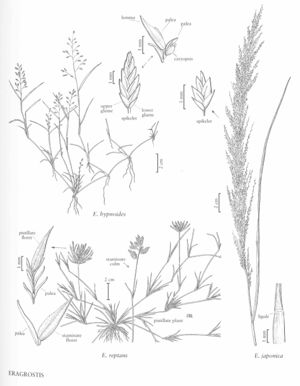Difference between revisions of "Eragrostis japonica"
imported>Volume Importer |
imported>Volume Importer |
||
| (One intermediate revision by the same user not shown) | |||
| Line 43: | Line 43: | ||
|publication year= | |publication year= | ||
|special status= | |special status= | ||
| − | |source xml=https:// | + | |source xml=https://bitbucket.org/aafc-mbb/fna-data-curation/src/200273ad09963decb8fc72550212de541d86569d/coarse_grained_fna_xml/V25/V25_113.xml |
|subfamily=Poaceae subfam. Chloridoideae | |subfamily=Poaceae subfam. Chloridoideae | ||
|tribe=Poaceae tribe Cynodonteae | |tribe=Poaceae tribe Cynodonteae | ||
Latest revision as of 17:55, 11 May 2021
Plants annual; cespitose, without innovations, without glands. Culms 25-100(115) cm, erect or geniculate, lower portion glabrous and shiny. Sheaths glabrous at the apices and on the upper margins; ligules 0.4-0.6 mm, scarious, glabrous; blades (4)15-20(25) cm long, 1.5-6 mm wide, flat, sometimes auriculate, abaxial surfaces glabrous, smooth, adaxial surfaces scabridulous, Panicles 15-40 cm long, 0.8-5 cm wide, lanceoloid, contracted, interrupted near the base; primary branches 2-10 cm, appressed or diverging to 30° from the rachises, spikelet-bearing to near the base; pulvini glabrous; pedicels 0.5-1.5 mm, sinuous. Spikelets 2.2-3.8 mm long, 0.8-1.3 mm wide, oblong to narrowly lanceolate, yellowish-brown to whitish and hyaline, with 4-12 florets; disarticulation basipetal, rachillas and glumes persistent. Glumes subequal, 0.6-1 mm, ovate to ovate-lanceolate, hyaline; upper glumes without a midvein; lemmas 0.9-1.2 mm, ovate, hyaline, lateral veins conspicuous basally, greenish, apices acute; paleas 0.6-0.8 mm, hyaline, keels smooth basally, scabridulous distally, apices acute, often bifid; anthers 2, 0.1-0.2 mm, whitish to light brown. Caryopses 0.3-0.4 mm, obovoid, smooth, reddish-brown. 2n = 20.
Distribution
Okla., Miss., Tex., La., Mo., Ala., Tenn., Ark., Ill., Ga., S.C., Fla.
Discussion
Eragrostis japonica is native to the tropics of the Eastern Hemisphere; it is now established in moist areas along rivers and streams in the southern portion of the contiguous United States, usually in sandy soils, at 0-200 m.
Selected References
None.
